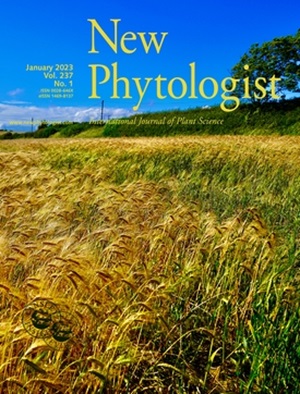The SLR1-OsMADS23-D14 module mediates the crosstalk between strigolactone and gibberellin signaling to control rice tillering
IF 8.3
1区 生物学
Q1 PLANT SCIENCES
引用次数: 0
Abstract
- Strigolactones (SLs) and gibberellins (GAs) have been found to inhibit plant branching or tillering, but molecular mechanisms underlying the interplay between SL and GA signaling to modulate tillering remain elusive.
- We found that the transcription factor OsMADS23 plays a crucial role in the crosslink between SL and GA signaling in rice tillering. Loss-of-function mutant osmads23 shows normal axillary bud formation but defective bud outgrowth, thus reducing the tiller number in rice, whereas overexpression of OsMADS23 significantly increases tillering by promoting tiller bud outgrowth.
- OsMADS23 physically interacts with DELLA protein SLENDER RICE1 (SLR1), and the interaction reciprocally stabilizes each other. Genetic evidence showed that SLR1 is required for OsMADS23 to control rice tillering. OsMADS23 acts as an upstream transcriptional repressor to inhibit the expression of SL receptor gene DWARF14 (D14), and addition of SLR1 further enhances OsMADS23-mediated transcriptional repression of D14, indicating that D14 is the downstream target gene of OsMADS23–SLR1 complex. Moreover, application of exogenous SL and GA reduces the protein stability of OsMADS23–SLR1 complex and promotes D14 expression.
- Our results revealed that SLs and GAs synergistically inhibit rice tillering by destabilizing OsMADS23–SLR1 complex, which provides important insights into the molecular networks of SL–GA synergistic interaction during rice tillering.
求助全文
约1分钟内获得全文
求助全文
来源期刊

New Phytologist
生物-植物科学
自引率
5.30%
发文量
728
期刊介绍:
New Phytologist is an international electronic journal published 24 times a year. It is owned by the New Phytologist Foundation, a non-profit-making charitable organization dedicated to promoting plant science. The journal publishes excellent, novel, rigorous, and timely research and scholarship in plant science and its applications. The articles cover topics in five sections: Physiology & Development, Environment, Interaction, Evolution, and Transformative Plant Biotechnology. These sections encompass intracellular processes, global environmental change, and encourage cross-disciplinary approaches. The journal recognizes the use of techniques from molecular and cell biology, functional genomics, modeling, and system-based approaches in plant science. Abstracting and Indexing Information for New Phytologist includes Academic Search, AgBiotech News & Information, Agroforestry Abstracts, Biochemistry & Biophysics Citation Index, Botanical Pesticides, CAB Abstracts®, Environment Index, Global Health, and Plant Breeding Abstracts, and others.
 求助内容:
求助内容: 应助结果提醒方式:
应助结果提醒方式:


